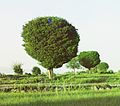| Ulmus 'Androssowii' | |
|---|---|
 Karagach [:black tree, = elm], Samarkand | |
| Genus | Ulmus |
| Cultivar | 'Androssowii' |
| Origin | Uzbekistan |
The hybrid cultivar Ulmus 'Androssowii'R. Kam. (or 'Androsowii' [1] ), an elm of Uzbekistan and Tajikistan [2] sometimes referred to in old travel books as 'Turkestan Elm' or as 'karagach' [:black tree, = elm], its local name, [3] is probably an artificial hybrid. According to Lozina-Lozinskaia the tree is unknown in the wild in Uzbekistan, [4] [5] and apparently arose from a crossing of U. densa var. bubyriana Litv. (now Ulmus minor 'Umbraculifera'), which it resembles (see the disputed species Ulmus densa), and the Siberian Elm Ulmus pumila. [6] It is sometimes listed as Ulmus × androssowii (see below). [7]
Contents
- Description
- Pests and diseases
- Cultivation
- Synonymy
- Accessions
- Nurseries
- Ulmus × androssowii
- References
- External links
Not to be confused with the Ulmus 'Turkestanica' distributed by the Späth nursery of Berlin.
For so-called Ulmus androssowii var. subhirsuta C. K. Schneid. and Ulmus androssowii var. virgata (Planch.) Grudz. , see Ulmus chumlia .








